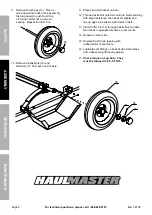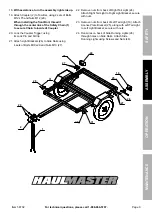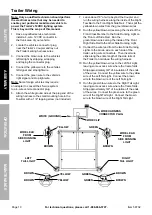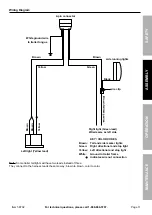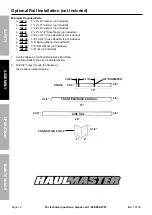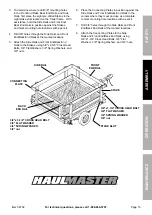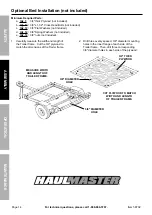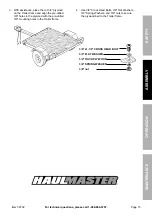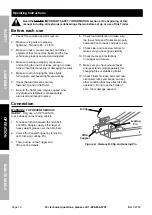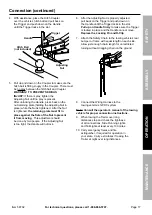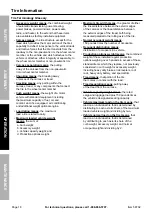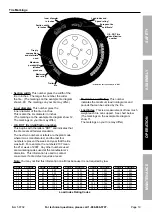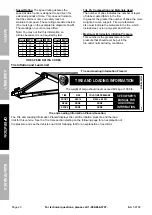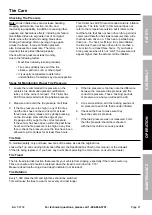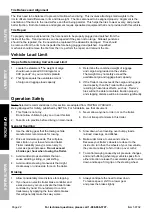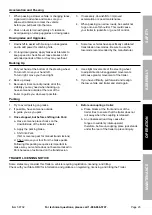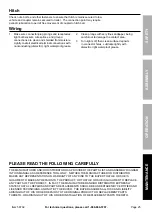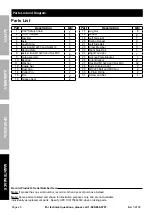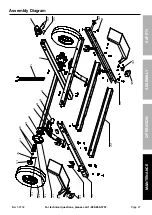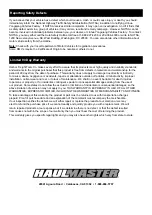
Page 22
For technical questions, please call 1-888-866-5797.
Item 58702
Sa
FE
ty
Op
E
ra
ti
O
n
M
aint
E
nan
CE
a
SSEMBL
y
tire Balance and alignment
The tires need to be balanced to prevent vibration when driving. This involves attaching small weights to the
rim to offset small differences in rim and tire weight. The tires also need to be aligned properly. Alignment is the
orientation of the tires to the road surface and their being parallel. This helps the tires to wear evenly, and provide
better traction. Both tire balance and alignment require specialized equipment that is not provided with this vehicle.
tire repair
To properly repair a punctured tire, the hole needs to be properly plugged and patched from the
inside of the tire. Tread punctures can be repaired if they are not too large. Sidewall punctures
should not be repaired, the tire needs to be replaced if the sidewall is damaged. Tires should
be removed from the rim to be inspected before being plugged and patched. A qualified
mechanic should remove the tire from the rim, perform the repair, and remount the tire.
Vehicle Load Limit
Steps for Determining Correct Load Limit
1. Locate the statement “The weight of cargo
should never exceed XXX kilograms or
XXX pounds” on your vehicle’s placard.
2. That figure equals the available amount
of cargo and luggage load capacity.
3. Determine the combined weight of luggage
and cargo being loaded on the vehicle.
That weight may not safely exceed the
available cargo and luggage load capacity.
4. If the Trailer’s load exceeds the cargo and luggage
load capacity, then the Trailer will be unsafe
resulting in hazardous effects, such as: Trailer’s
tires will not be able to maintain traction properly,
and stopping distance will be increased significantly.
Operation Safety
note:
Selected recommendations in this section are adapted from
TOWING A TRAILER -
Being Equipped for Safety
, published by NHTSA. For full details, see that document.
1. This Trailer is not a toy.
Do not allow children to play on or near this item.
2. Take time to practice before driving on main roads.
3. Never allow anyone to ride in or on the trailer.
4. Do not transport animals in this trailer.
General Handling
1. Use the driving gear that the towing vehicle
manufacturer recommends for towing.
2. Drive at moderate speeds. This will place
less strain on your tow vehicle and trailer.
Trailer instability (sway) is more likely to
occur as speed increases.
Do not exceed
45 miles per hour when towing the trailer.
3. Avoid sudden stops and starts that can
cause skidding, sliding, or jackknifing.
4. Avoid sudden steering maneuvers that might
create sway or undue side force on the trailer.
5. Slow down when traveling over bumpy roads,
railroad crossings, and ditches.
6. Make wider turns at curves and corners.
Because your trailer’s wheels are closer to the
inside of a turn than the wheels of your tow vehicle,
they are more likely to hit or ride up over curbs.
7. To control swaying caused by air pressure changes
and wind buffeting when larger vehicles pass from
either direction, release the accelerator pedal to slow
down and keep a firm grip on the steering wheel.
Braking
1. Allow considerably more distance for stopping.
2. If you have an electric trailer brake controller and
excessive sway occurs, activate the trailer brake
controller by hand. Do not attempt to control
trailer sway by applying the tow vehicle brakes;
this will generally make the sway worse.
3. Always anticipate the need to slow down.
To reduce speed, shift to a lower gear
and press the brakes lightly.

